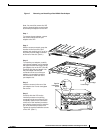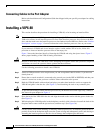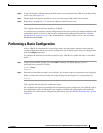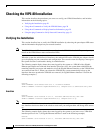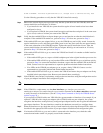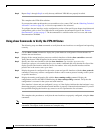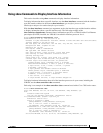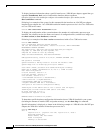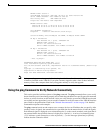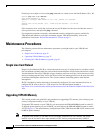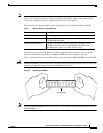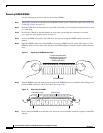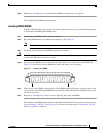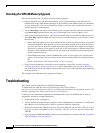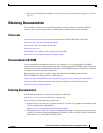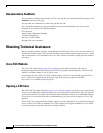
31
Versatile Interface Processor (VIP6-80) Installation and Configuration Guide
OL-5078-01
EEPROM format version 1
VIP6 RM7000B controller, FRU:VIP6, HW rev 2.03, board revision B0
Serial number:24632085 Part number:73-3143-09
Test history:0x00 RMA number:00-00-00
Flags:cisco 7000 board; 7500 compatible
EEPROM contents (hex):
0x20:01 4E 02 03 01 77 DB 15 49 0C 47 09 00 00 00 00
0x30:58 00 00 00 00 00 00 00 00 00 00 00 00 00 00 00
Slot database information:
Flags:0x4 Insertion time:0x1C54 (00:02:56 ago)
Controller Memory Size:128 MBytes CPU SDRAM, 64 MBytes Packet SDRAM
PA Bay 0 Information:
Fast-Ethernet PA, 1 ports, 100BaseFX-ISL
EEPROM format version 1
HW rev 1.00, Board revision B0
Serial number:03538256 Part number:73-1690-04
PA Bay 1 Information:
Fast-Ethernet PA, 1 ports, 100BaseFX-ISL
EEPROM format version 1
HW rev 1.00, Board revision B0
Serial number:06685419 Part number:73-1690-04
--Boot log begin--
INFORMATION ABOUT THE UNIT UNDER TEST *****
Cisco Internetwork Operating System Software
IOS (tm) RSP Software (RSP-PV-M), Experimental Version 12.1(20020206:203420) [mssunil-vip6
122]
Copyright (c) 1986-2002 by cisco Systems, Inc.
Compiled Thu 07-Feb-02 09:05 by mssunil
Image text-base:0x60010958, data-base:0x6113A000
Note In the preceding command output, the line that begins with Controller Memory Size shows the amount
of memory installed on the VIP6-80. If you plan a memory upgrade, make a note of these indicated
memory values, then compare them after you upgrade memory to verify the upgrade.
Using the ping Command to Verify Network Connectivity
This section provides brief descriptions of the ping command. The ping command allows you to verify
that an interface port is functioning properly and to check the path between a specific port and connected
devices at various locations on the network. After you verify that the system and VIP6-80 have booted
successfully and are operational, you can use this command to verify the status of the VIP6-80 interface
ports. Refer to the publications listed in the “Related Documentation” section on page 2 for detailed
command descriptions and examples.
The ping command sends an echo request out to a remote device at an IP address that you specify. After
sending a series of signals, the command waits a specified time for the remote device to echo the signals.
Each returned signal is displayed as an exclamation point (!) on the console terminal; each signal that is
not returned before the specified timeout is displayed as a period (.). A series of exclamation points
(!!!!!) indicates a good connection; a series of periods (.....) or the messages [timed out] or [failed]
indicate that the connection failed.



